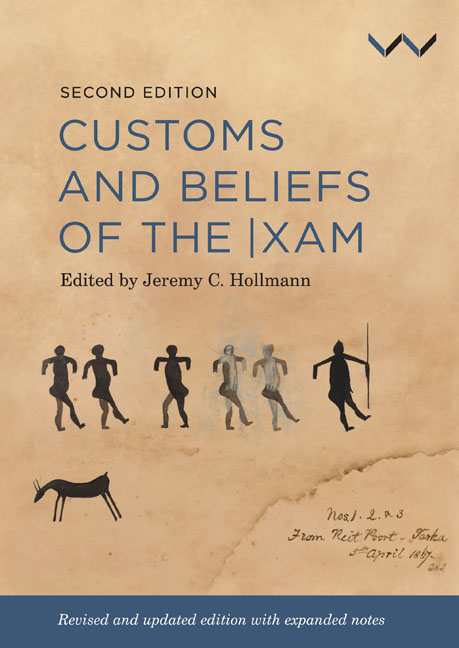Book contents
- Frontmatter
- Dedication
- Contents
- Acknowledgements
- Foreword To The Second Edition
- Foreword To The First Edition
- Introduction
- Contributors
- The |Xam Language
- The People In The Notebooks
- Part 1 Baboons
- Part 2 The Lion
- Part 3 Game Animals
- Part 4 Omens, Windmaking, Clouds
- Part 5 Rain
- Part 6 Rainmaking
- Part 7 Sorcerers
- Part 8 More About Sorcerers and Charms
- Part 9 Special Speech of Animals and Moon
- Appendix 1 |Xam Grammar
- Appendix 2 Summary of The Narratives
- References
- Index
Part 7 - Sorcerers
Published online by Cambridge University Press: 24 November 2023
- Frontmatter
- Dedication
- Contents
- Acknowledgements
- Foreword To The Second Edition
- Foreword To The First Edition
- Introduction
- Contributors
- The |Xam Language
- The People In The Notebooks
- Part 1 Baboons
- Part 2 The Lion
- Part 3 Game Animals
- Part 4 Omens, Windmaking, Clouds
- Part 5 Rain
- Part 6 Rainmaking
- Part 7 Sorcerers
- Part 8 More About Sorcerers and Charms
- Part 9 Special Speech of Animals and Moon
- Appendix 1 |Xam Grammar
- Appendix 2 Summary of The Narratives
- References
- Index
Summary
Of all the narratives that Dorothea Bleek gathered together for Bantu Studies, Part 7 could be considered the single richest source of insight into |xɑm cosmology. The ideas, concepts and beliefs presented here about ǃgiː (‘magic power, sorcery’, Bleek 1956: 382), ‖keːŋ (‘magic, sorcery’, Bleek 1956: 569) and |kóːöde (‘magic things, magic doings, magic power’, Bleek 1956: 320) characterise the |xɑm world view. These beliefs underlie every other facet of the |xɑm world described in the Bantu Studies series, from the significance of baboons in Part 1 to the speech of animals and the Early Race people in Part 9.
Not surprisingly, Part 7 has the most narratives and is also the longest of all the parts Dorothea prepared for Bantu Studies. Presented by the three main |xɑm narrators – ‖kɑbbo (one narrative), Diäǃkwɑin (fifteen) and |hɑŋǂkɑssʼo (five) – they are rich in the detail of healing practices.
The anatomy of sorcery
The narrators in Part 7 talk about how ǃgiː affects the body. Significantly, the word ǃgiːxɑ (the |xɑm word translated by Bleek and Lloyd as ‘sorcerer’) emphasises the powerful, all-embracing effects of ǃgiː. The word is compounded from ǃgiː, ‘magic power’ (Bleek 1956: 382), and the suffix -xɑ, an ‘ending similar to -ful’ (Bleek 1956: 255), thus meaning ‘full of ǃgiː’. Dorothea Bleek explains her use of the words ‘medicine men’ and ‘sorcerers’ in her introduction to this part in Bantu Studies:
In Part VI of Customs and Beliefs of the |xɑm Bushmen, published in Vol VII No 4 of Bantu Studies reference has been made to the ‘Medicine men’ of the Bushmen. The term was used by me, as I think it is the word most generally employed to designate a worker in magic whose object is the cure of illness or any other beneficient [sic] activity. The word used by Miss Lloyd is ‘sorcerer’, whether the actions described are helpful or harmful; the |xɑm only use one word in both cases. On the advice of Professor Maingard I am following the first translation as closely as possibly [sic], am therefore using only the word ‘sorcerer’ in this number.
ǃgiː was literally in the blood: it was carried in a sorcerer's |xuttǝn|xuttǝn, translated as ‘blood vessels’, ‘arteries’ and ‘senses’. Diäǃkwɑin mentions a particular artery, the ǃkháũä – the so-called ‘vertebral artery’ – that was the conduit of ǃgiː (see notes to Narrative 7.12).
Information
- Type
- Chapter
- Information
- Customs and Beliefs of the |xam , pp. 271 - 374Publisher: Wits University PressPrint publication year: 2022
